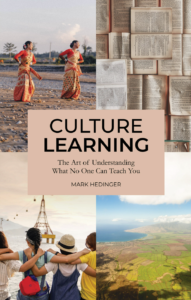
Culture Learning: The Art of Understanding What No One Can Teach You by Mark Hedinger, edited by Rachel Askew. Self-published by Mark Hedinger and CultureBound, 2021, 168 pages. ISBN-13: 979-8985372137. Available from Amazon.
In my role as an intercultural trainer for the past thirty years, I have encountered and used a variety of models used to describe and analyze culture. Many of you are probably familiar with the iceberg model, developed by Edward T. Hall in the 1970s, that shows how there are visible and invisible features of culture.
Another model that I have used in training programs is the Culture Compass, developed by Dr. Geert Hofstede, which identifies different dimensions of culture.
After reading Mark Hedinger’s book, Culture Learning: The Art of Understanding What No One Can Teach You, I have another model to add to my training repertoire: the Culture Tree.
Dr. Mark Hedinger is the president of CultureBound, an intercultural training organization based in Portland, Oregon, whose mission is to “increase the effectiveness of gospel ministry by facilitating intercultural understanding.”
This book is written primarily for Christians serving cross-culturally, either abroad or in their home countries. It is broadly divided into two sections.
The first five chapters focus on the foundational issues in culture learning, which, the author reminds us, is a journey “to connect your mind and heart with the minds and hearts of people from other cultures” (p. 57).
The biblical ground of this journey is the promise that Jesus is now building a church that will include people of every tribe, language, ethnicity, and nation. This is why we cross cultural boundaries.
Hedinger refers to culture learning as syncing, or “growing to the point where your thoughts and expressions synchronize with others” (p. 70). This is what allows us to communicate gospel truths on a deeper level. He reminds us that culture learning can take place only in the context of relationships (both vertical and horizontal).
In chapter six, he introduces us to the Culture Tree, which allows us “to see how the pieces of a culture work together while also acknowledging the living, responsive nature of a given tribe, language, people, and nation” (p. 59).
Nine Elements of Culture
- roots (core values);
- soil line (environment);
- tree rings (history);
- trunk (social networks);
- branches (organizational structures);
- leaves (production, work);
- fruit (reproduction);
- the ecosystem (contact between cultures);
- toxins and nutrients (healthy and unhealthy patterns).
Hedinger summarizes the Culture Tree this way:
One of the beautiful things about symbolizing cultures with trees is that this picture captures the essence of variation and uniqueness among groups. There are cultures that value their past and others that live for today. There are cultures that have centuries of experience and others that are newly developing. There are some that create elaborate social structures and others that develop a simple collection of family groups. The image of the tree allows you to first think about commonalities by acknowledging all trees have the same parts, and then to address differences by thinking of the many different types of trees (p. 60).
In chapters seven, eight, and nine, Hedinger focuses on the skills and attitudes required for effective culture learning. I appreciated the practical nature of these chapters, which included specific learning activities that can be used in analyzing the nine elements of culture depicted in the Culture Tree.
Another practical feature of this book is the discussion and reflection questions at the end of each chapter. These are suitable for both individuals and groups engaged in culture learning.
I highly recommend this book to anyone preparing for cross-cultural service abroad, as well as for those who are serving among immigrant communities in their home countries. The concepts and tools presented will deepen understanding and open pathways for gospel conversations.
As for me, I intend to incorporate some of the ideas from this book in a culture learning program I will be teaching later in the year.
Our thanks to CultureBound for providing a copy of Culture Learning: The Art of Understanding What No One Can Teach You by Mark Hedinger for this review.
Image credit: Ralph Kranslein via Flicker.

Joann Pittman
Joann Pittman is Vice President of Partnership and China Engagement and editor of ZGBriefs. Prior to joining ChinaSource, Joann spent 28 years working in China, as an English teacher, language student, program director, and cross-cultural trainer for organizations and businesses engaged in China. She has also taught Chinese at the University …View Full Bio
Are you enjoying a cup of good coffee or fragrant tea while reading the latest ChinaSource post? Consider donating the cost of that “cuppa” to support our content so we can continue to serve you with the latest on Christianity in China.